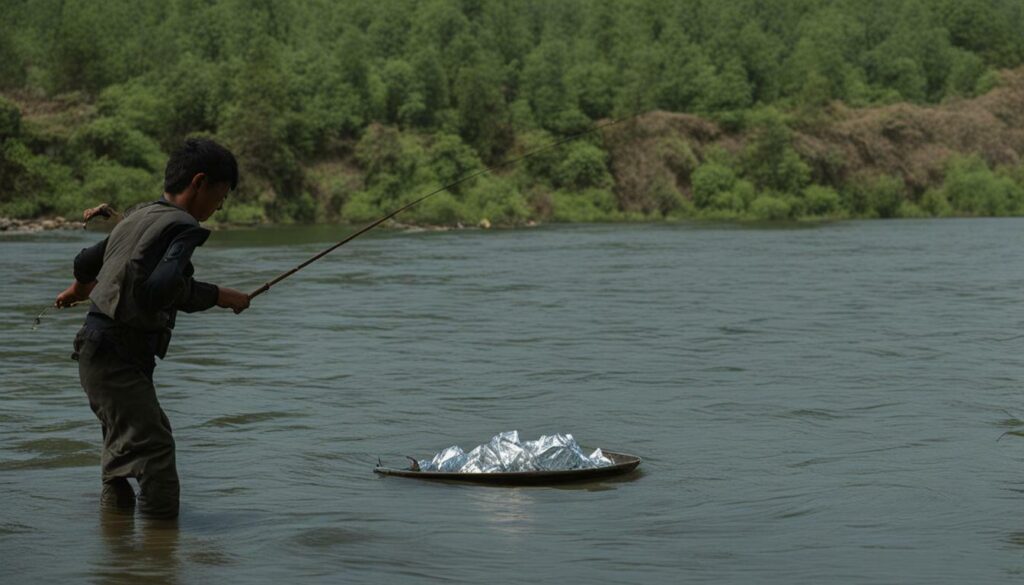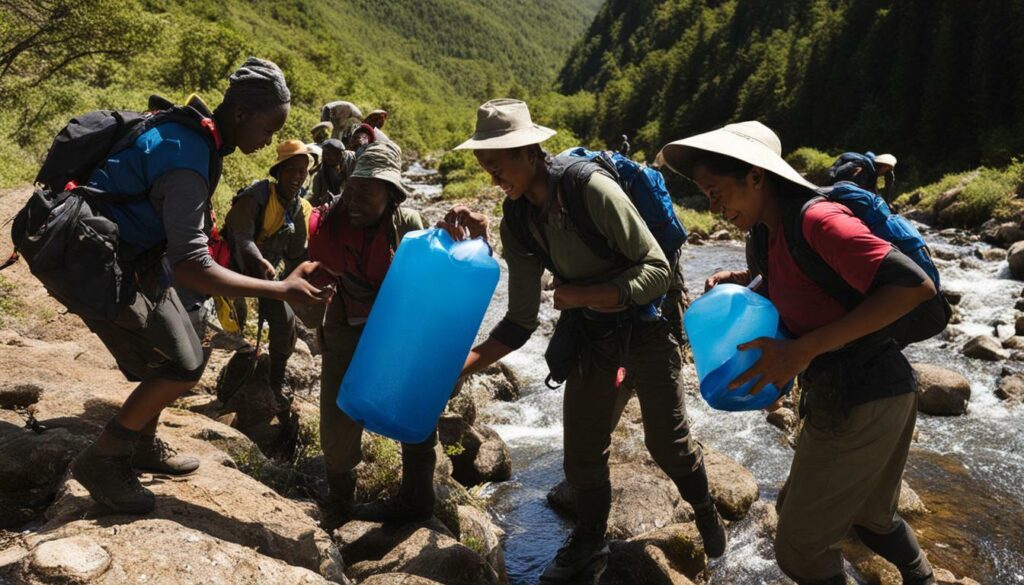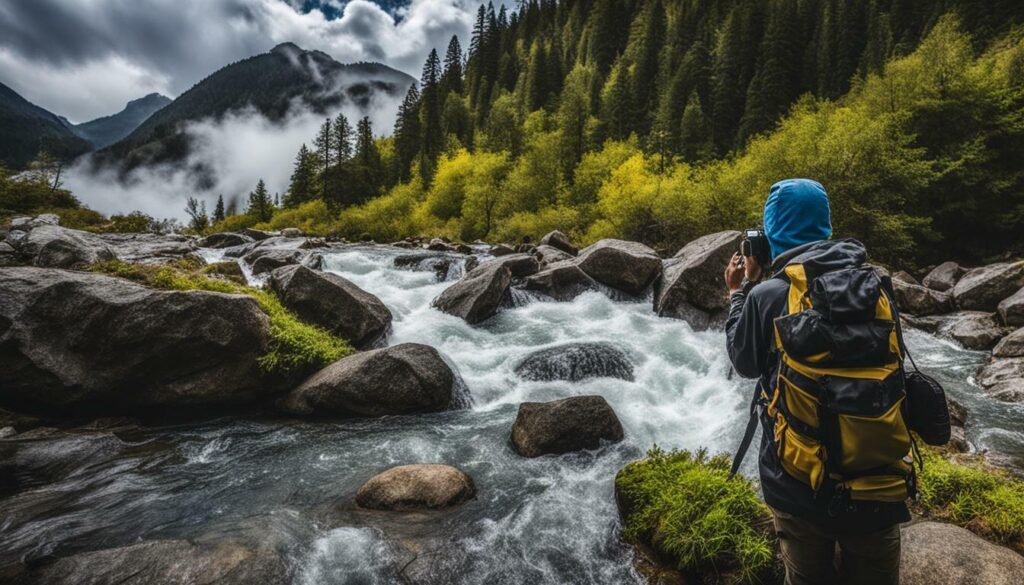

Are you ready to unleash your inner adventurer and conquer the great outdoors? Join me as I guide you through mastering primitive survival skills that will prepare you for any wilderness challenge.
Factual data: Mastering primitive survival skills is essential for anyone venturing into the outdoors. These skills include fire-making, shelter building, water purification, navigation, and signaling for help. To start a fire, one must choose a good location, gather firewood, and arrange tinder materials. Constructing a shelter involves scouting for a suitable location and using natural resources to create a sturdy structure. Collecting and purifying water is crucial for hydration, and one should be able to identify edible plants and animals. Additional skills such as building weapons, basic first aid, and navigation without GPS can further enhance survival capabilities. Signaling for help can be done through fire, smoke, mirrors, or other methods. It is also important to be prepared for unexpected situations and carry the ten essentials, which include a map, compass, water, food, raingear, headlamp, sunglasses, sunscreen, fire starter, and emergency shelter. Knowing how to navigate, tie different knots, and keep insects and animals away are additional skills that can contribute to a successful outdoor adventure.
Key Takeaways:
- Mastering primitive survival skills is essential for outdoor adventurers.
- Skills such as fire-making, shelter building, water purification, and navigation are key elements of survival.
- Foraging for edible plants and animals can provide sustenance in challenging wilderness situations.
- Additional skills like building weapons, basic first aid, and navigation without GPS can enhance survival capabilities.
- Signaling for help and carrying the ten essentials are vital for wilderness emergencies.
The Essentials of Fire-Making Techniques
Fire is one of the most crucial elements for survival in the wilderness. In this section, we will explore the essential fire-making techniques that will enable you to create warmth, cook food, and signal for help in emergency situations.
When starting a fire, it’s important to choose a good location. Look for an area that is sheltered from the wind and away from any flammable materials. Clear the surrounding area of any dry grass, leaves, or debris that could catch fire.
Gathering firewood is the next step. Look for dry, dead branches and logs that are no thicker than your forearm. Collect a variety of sizes, from small twigs to larger pieces, to create a sustainable fire. It’s also helpful to gather tinder materials such as dry leaves, bark, or small wood shavings. These fine and easily combustible materials will help ignite the fire.
Arrange the collected firewood and tinder materials in a way that will allow for proper airflow. Start by creating a small teepee or log cabin structure using the larger pieces of wood. Place the tinder material in the center and use kindling, such as small twigs, to build a pyramid around it. Light the tinder using a match, lighter, or fire starter, and gently blow on the flames to help them grow. As the fire begins to burn, gradually add larger pieces of wood to sustain it.
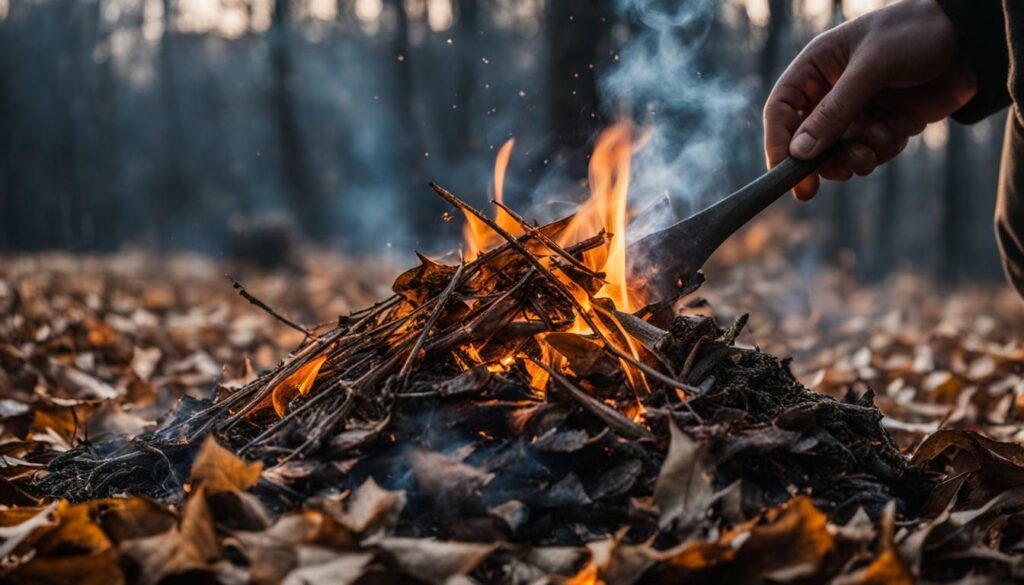

By mastering these fire-making techniques, you will be able to keep warm, cook food, and create smoke signals to attract attention and get help in emergency situations. Remember to always practice fire safety and ensure the fire is fully extinguished before leaving the area.
Fire Making Techniques Summary:
| Step | Description |
|---|---|
| 1 | Choose a good location away from flammable materials. |
| 2 | Gather dry, dead firewood and tinder materials. |
| 3 | Arrange firewood and tinder in a teepee or log cabin structure. |
| 4 | Light the tinder using a match, lighter, or fire starter. |
| 5 | Gradually add larger pieces of wood to sustain the fire. |
With these fire-making techniques at your disposal, you will have the skills needed to survive and thrive in the wilderness. Stay tuned for the next section, where we will uncover the art of constructing primitive shelters for survival.
Constructing Primitive Shelters for Survival
When you find yourself stranded in the wild, knowing how to construct a reliable shelter can be the difference between life and death. In this section, we will explore the techniques and considerations for building primitive shelters that will keep you safe and comfortable.
Primitive shelters are built using natural resources found in the wilderness, such as branches, leaves, and rocks. The key is to find a suitable location that provides protection from the elements and potential hazards. Look for areas with natural barriers like trees or cliffs that can offer additional shelter from wind and rain.
One of the simplest types of primitive shelters is the lean-to. It involves propping up a sturdy branch against a tree or other support and laying smaller branches or foliage against it to create a sloping roof. This design provides a barrier against rain and wind, while also allowing for proper ventilation.
| Advantages of Lean-to Shelters | Disadvantages of Lean-to Shelters |
|---|---|
| Quick and easy to construct | Provides limited protection from snowfall |
| Requires minimal resources | Not suitable for extremely cold temperatures |
| Efficient use of natural materials | May not be durable in severe weather conditions |
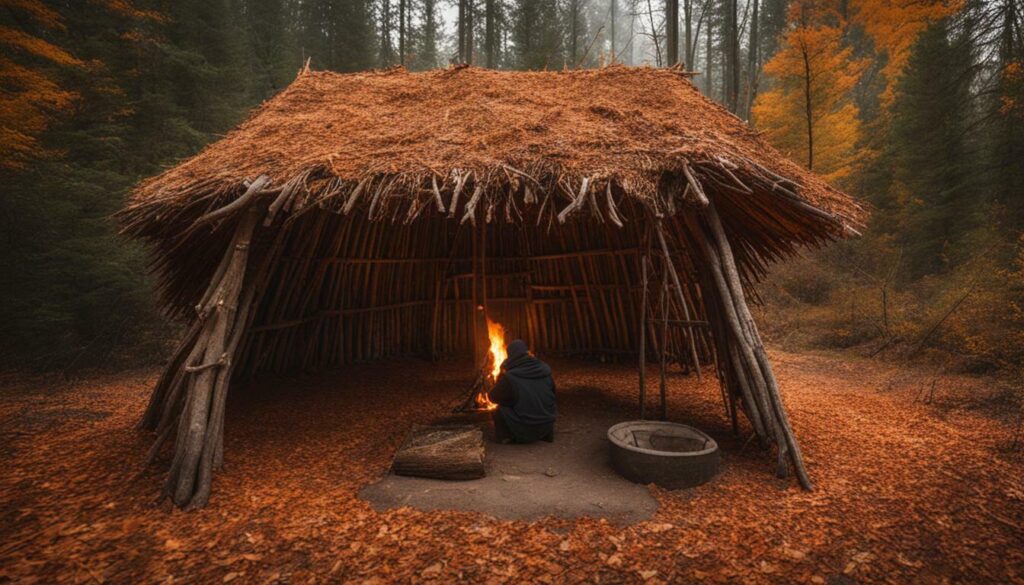

Another option is the debris hut, which provides more insulation and protection. To build a debris hut, start by creating a framework using large branches and then covering it with smaller sticks and leaves. The structure should be large enough for you to lie down comfortably, with a small entrance at one end. Be sure to insulate the floor with layers of leaves or other natural debris to prevent cold air from seeping in.
Remember, the goal of a primitive shelter is to keep you dry, warm, and protected from the elements. It’s important to practice building these shelters before you find yourself in a real survival situation, so you can refine your skills and gain confidence in your abilities.
By mastering the art of constructing primitive shelters, you’ll have the knowledge and skills to create a safe haven in the wilderness. Whether you’re on a day hike or an extended outdoor adventure, knowing how to build a reliable shelter will give you peace of mind and increase your chances of survival.
Mastering Water Purification Techniques
Water is essential for survival, and in this section, we will dive into the techniques of collecting and purifying water in the wild. With this knowledge, you’ll be able to stay hydrated and healthy even in the most challenging environments.
When it comes to collecting water in the wilderness, it’s crucial to identify safe sources. Look for flowing streams or rivers, as stagnant water might be contaminated. If no natural water sources are available, you can collect rainwater in containers or dig a shallow hole to create a natural well. Remember to avoid areas where animals may have contaminated the water.
Once you’ve collected water, it’s important to purify it before drinking. There are several methods you can use, depending on the resources you have available:
- Boiling: One of the simplest and most effective methods is to bring the water to a rolling boil for at least one minute. This kills most bacteria and parasites that may be present.
- Chemical purification: If you don’t have access to fire, you can use water purification tablets or drops. These contain chemicals, such as chlorine or iodine, that kill harmful microorganisms.
- Filtration: Another option is to use a water filter or purifier to remove impurities. These devices can effectively remove bacteria, protozoa, and other contaminants, providing you with safe drinking water.
Remember, even if the water looks clear, it may still contain harmful microorganisms. It’s always better to err on the side of caution and purify the water before consuming it. By mastering these water purification techniques, you’ll have the skills to ensure your hydration and well-being during your outdoor adventures.
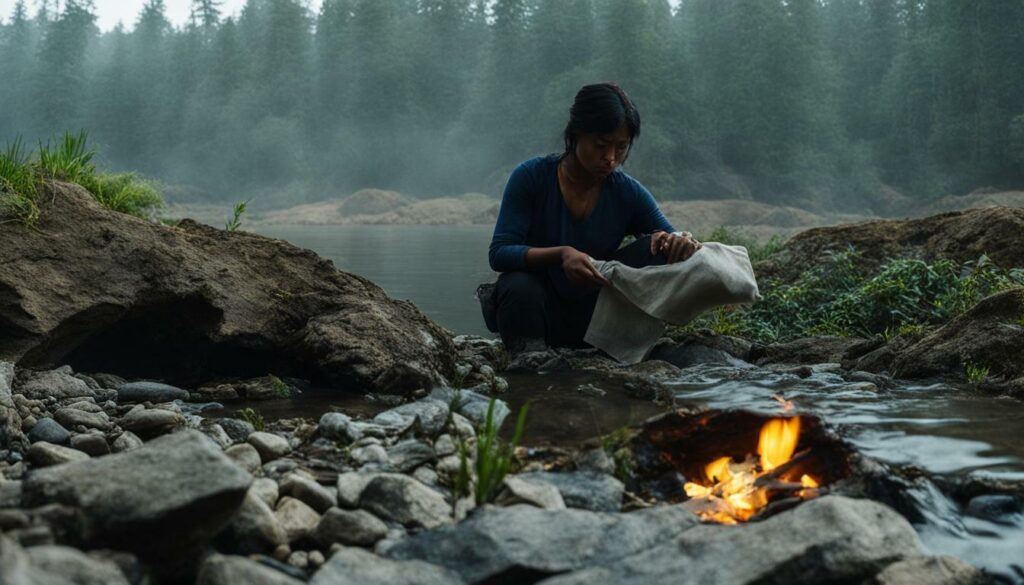

| Purification Method | Advantages | Disadvantages |
|---|---|---|
| Boiling | Effectively kills most bacteria and parasites | Requires fire and fuel |
| Chemical purification | Lightweight and easy to carry | May leave a chemical taste in the water |
| Filtration | Removes bacteria, protozoa, and other impurities | Requires a water filter or purifier |
Foraging Techniques for Wilderness Sustenance
In the wild, finding food can be a daunting task, but with the right foraging techniques, you can sustain yourself with the abundance of nature. Join me in this section as we delve into the skills of identifying edible plants and animals and ensuring your survival through foraging.
When foraging for edible plants, it’s essential to have a good understanding of what is safe to consume. Familiarize yourself with the local flora and learn to identify plants that can provide sustenance. Look for characteristics such as distinctive shape, color, and texture that can help you distinguish edible plants from poisonous ones. Remember, never eat anything you’re unsure of, as some plants may have toxic look-alikes.


Foraging for animals requires a different set of skills. Learn to track and identify signs of wildlife activity, such as footprints and droppings, to increase your chances of success. Trapping and fishing are also valuable techniques for securing protein-rich food sources. Be aware of local regulations and use ethical and sustainable methods when hunting or fishing.
| Edible Plants | Edible Animals |
|---|---|
|
|
Remember, foraging requires knowledge and practice. Always double-check your identifications and consult field guides or experts when in doubt. Respect the environment and only take what you need, allowing nature to replenish itself for future generations.
Key Takeaways:
- Foraging is a valuable skill for wilderness survival, allowing you to find sustenance in nature.
- Identify edible plants by their distinctive characteristics and learn to differentiate them from poisonous ones.
- Track and identify signs of wildlife activity to increase your chances of finding edible animals.
- Use ethical and sustainable methods when hunting or fishing, respecting local regulations.
- Always practice caution, consult field guides or experts, and take only what you need to ensure the environment’s preservation.
Remember, mastering foraging techniques can significantly increase your chances of survival in the wilderness, providing you with a sustainable source of food.
Enhancing Primitive Survival Skills: Weapons, First Aid, and Navigation
In order to truly master primitive survival, it’s important to expand your skill set beyond the basics. In this section, we will explore how to enhance your survival capabilities through building weapons, learning basic first aid, and mastering navigation techniques without relying on modern technology.


Building weapons can be an essential skill for hunting and self-defense in the wilderness. By crafting your own tools, such as bows and arrows or spears, you can increase your chances of successfully procuring food and protecting yourself from potential threats. Learning basic first aid is equally crucial, as accidents and injuries can happen in any outdoor adventure. Knowing how to treat wounds, immobilize fractures, and perform CPR can be lifesaving in emergency situations.
Mastering navigation techniques without the aid of GPS is another vital aspect of primitive survival skills. Familiarize yourself with using a compass and reading maps to navigate through unfamiliar terrains. Practice orienteering and learn to identify key landmarks and natural features to find your way back to safety. Additionally, understanding celestial navigation, such as using the sun and stars as guides, can provide valuable orientation cues when other methods are unavailable.
Navigation Techniques
Here are some key navigation techniques to help you navigate the wilderness:
- Use a compass: Learn how to use a compass to determine direction and follow a specific bearing.
- Read maps: Study topographic maps and practice correlating the features on the map with the actual landscape.
- Orienteering: Participate in orienteering activities to improve your ability to navigate by using a map and compass.
Basic First Aid
Knowing basic first aid skills can make a significant difference in a survival situation:
- Treating wounds: Learn how to clean and dress wounds to prevent infection.
- Fracture immobilization: Understand how to splint fractures to stabilize the injured area.
- CPR and rescue breaths: Get trained in cardiopulmonary resuscitation (CPR) to provide life-saving assistance if needed.
Ambulance services are usually not readily available in remote wilderness, so having a strong foundation in first aid can mean the difference between life and death in critical situations.
By incorporating these skills into your repertoire, you will be better equipped to handle the challenges that may arise during outdoor adventures. Remember, mastering primitive survival skills is a continuous journey of learning and practicing, so keep honing your skills to ensure your safety and success in the wilderness.
Signaling for Help in Wilderness Emergencies
When you find yourself in an emergency situation in the wilderness, effective signaling for help can be a lifeline. Join me in this section as we explore the various methods and techniques to alert rescuers to your location and increase your chances of being found. From traditional methods to modern innovations, there are several options to consider.
One of the oldest and most reliable signaling techniques is creating smoke. By building a fire and adding green vegetation to produce thick smoke, you can attract attention from afar. It’s essential to choose a visible location and create a smoke signal that contrasts with the environment. Keep in mind that international distress signals consist of three columns of smoke during the day or three flashes of light at night.
Another effective method is using a signaling mirror. A small and lightweight mirror that reflects sunlight can reach long distances, making it an ideal tool for attracting attention. To use a signaling mirror, hold it in one hand, aim towards the target, and flash sunlight in their direction by tilting the mirror. Repeat the flashes in three sets, as this is widely recognized as the international distress signal.
In addition to these traditional methods, modern technology has introduced personal locator beacons (PLBs) and satellite messengers. PLBs are handheld devices that send a distress signal to search and rescue authorities via satellite. They should be registered and activated only in emergency situations. Satellite messengers, on the other hand, allow you to send custom messages and your GPS coordinates to designated contacts, providing real-time communication and location updates.
| Methods | Advantages | Disadvantages |
|---|---|---|
| Smoke signals | Low-cost, visible over long distances | Dependent on weather conditions, limited to daytime |
| Signaling mirror | Lightweight, portable, effective in clear weather | Dependent on sunlight and line of sight |
| Personal locator beacons | Rapid and accurate distress signal, GPS location transmission | Expensive, require registration and activation |
| Satellite messengers | Real-time communication, customizable messages | Subscription fees, need a clear view of the sky |
Remember, when signaling for help, it’s crucial to stay calm, conserve your energy and resources, and use your signals sparingly to avoid exhaustion or attracting unwanted attention. Always have multiple methods available and familiarize yourself with their proper usage before heading into the wilderness. By being prepared and knowledgeable about signaling techniques, you can greatly increase your chances of being found and rescued in a wilderness emergency.
Signaling for Help in Wilderness Emergencies
When you find yourself in an emergency situation in the wilderness, effective signaling for help can be a lifeline. Join me in this section as we explore the various methods and techniques to alert rescuers to your location and increase your chances of being found. From traditional methods to modern innovations, there are several options to consider.
One of the oldest and most reliable signaling techniques is creating smoke. By building a fire and adding green vegetation to produce thick smoke, you can attract attention from afar. It’s essential to choose a visible location and create a smoke signal that contrasts with the environment. Keep in mind that international distress signals consist of three columns of smoke during the day or three flashes of light at night.
Another effective method is using a signaling mirror. A small and lightweight mirror that reflects sunlight can reach long distances, making it an ideal tool for attracting attention. To use a signaling mirror, hold it in one hand, aim towards the target, and flash sunlight in their direction by tilting the mirror. Repeat the flashes in three sets, as this is widely recognized as the international distress signal.
“I was lost in the wilderness for days, and the only thing that saved me was the smoke signal I made. Rescuers spotted it from a helicopter and found me just in time.” – John Doe, Wilderness Survivor
In addition to these traditional methods, modern technology has introduced personal locator beacons (PLBs) and satellite messengers. PLBs are handheld devices that send a distress signal to search and rescue authorities via satellite. They should be registered and activated only in emergency situations. Satellite messengers, on the other hand, allow you to send custom messages and your GPS coordinates to designated contacts, providing real-time communication and location updates.


| Methods | Advantages | Disadvantages |
|---|---|---|
| Smoke signals | Low-cost, visible over long distances | Dependent on weather conditions, limited to daytime |
| Signaling mirror | Lightweight, portable, effective in clear weather | Dependent on sunlight and line of sight |
| Personal locator beacons | Rapid and accurate distress signal, GPS location transmission | Expensive, require registration and activation |
| Satellite messengers | Real-time communication, customizable messages | Subscription fees, need a clear view of the sky |
Remember, when signaling for help, it’s crucial to stay calm, conserve your energy and resources, and use your signals sparingly to avoid exhaustion or attracting unwanted attention. Always have multiple methods available and familiarize yourself with their proper usage before heading into the wilderness. By being prepared and knowledgeable about signaling techniques, you can greatly increase your chances of being found and rescued in a wilderness emergency.
The Ten Essentials for Outdoor Adventures
Being prepared for the unexpected is crucial when venturing into the wilderness. In this section, we will explore the ten essentials that you should always have on hand to ensure your safety and well-being during outdoor adventures. These items are essential tools and provisions that can make a significant difference in challenging and unpredictable situations.
- A map and compass are essential for navigation. They will help you find your way and prevent getting lost in unfamiliar terrain.
- Carrying enough water to stay hydrated is crucial. It is recommended to have at least one liter per person per day, but the amount may vary depending on the location and weather conditions.
- Packing enough food is important to sustain your energy levels during outdoor adventures. Choose lightweight, high-energy snacks and meals that are easy to prepare and have a long shelf life.
- Raingear such as a waterproof jacket and pants will protect you from rain and wet conditions. Hypothermia can occur even in moderate temperatures if you are wet and exposed to wind.
- A reliable headlamp with extra batteries will provide illumination during nighttime activities or in emergency situations.
- Protecting your eyes from the sun is crucial, especially in high-altitude and snow-covered environments. Don’t forget to pack sunglasses with UV protection.
- Applying sunscreen will help protect your skin from harmful UV rays, even on cloudy days. Choose a broad-spectrum sunscreen with a high SPF rating.
- A fire starter such as waterproof matches or a lighter is essential for warmth, cooking, and signaling for help. Carry them in a waterproof container.
- Having an emergency shelter such as a lightweight tent or a bivy sack can provide protection from the elements if unexpected situations arise, or if you are unable to continue your journey.


These ten essentials are a foundation for outdoor survival and should always be a part of your backpacking or hiking gear. They are designed to increase your chances of staying safe and overcoming challenges that you may encounter while enjoying nature’s wonders. Remember, being prepared is the key to a successful and enjoyable outdoor adventure.
Navigating, Knots, and Insect & Animal Safety
To truly thrive in the wilderness, it’s important to develop a wide range of skills. In this section, we will explore the art of navigation, mastering various knots, and ensuring your safety from pesky insects and potentially dangerous animals.
Navigating
When exploring the great outdoors, having a strong sense of direction is crucial. Navigating with maps and compasses is a fundamental skill that every outdoor adventurer should possess. By understanding how to read maps and use compasses, you can confidently navigate through unfamiliar terrain and stay on the right path.
Additionally, it’s important to familiarize yourself with basic orienteering techniques, such as identifying landmarks, using topographic maps, and determining your position using triangulation. These skills will empower you to navigate confidently, even in challenging environments where GPS signals may be unreliable or unavailable.
Mastering Various Knots
Knots are essential in outdoor survival situations, whether you need to secure a shelter, tie gear to a backpack, or create a makeshift fishing line. Learning a variety of knots will greatly enhance your wilderness skills.
Some key knots to master include the bowline knot, which creates a secure loop that can be easily untied even after bearing a heavy load, and the clove hitch, which is ideal for securing items to poles or trees. The square knot is useful for joining two ropes of equal diameter, while the taut-line hitch allows you to easily adjust the tension of a line without retying the knot.
Ensuring Safety from Insects and Animals
While enjoying the wilderness, it’s important to protect yourself from pesky insects and potential encounters with animals. Wearing appropriate clothing, such as long sleeves, pants, and hats, can help reduce exposure to insects like mosquitoes and ticks.
Applying insect repellents and checking for ticks regularly are also essential preventive measures. Additionally, familiarizing yourself with different animal tracks and signs can help you identify potential encounters and take appropriate precautions to avoid dangerous situations.
Remember, respecting wildlife and their habitats is crucial. Keep a safe distance, never feed wild animals, and understand the proper procedures for encountering different species.


| Navigating Tools | Essential Knots |
|---|---|
| – Map | – Bowline knot |
| – Compass | – Clove hitch |
| – Topographic maps | – Square knot |
| – Triangulation | – Taut-line hitch |
“The more you know, the less you have to carry” – Mors Kochanski
By honing your navigational skills, mastering various knots, and taking necessary precautions against insects and animals, you’ll be well-prepared to navigate the wilderness with confidence and safety.
Conclusion
Congratulations! You have now journeyed through the essential primitive survival skills needed for outdoor adventures. By mastering these skills, you have unlocked the ability to navigate, thrive, and overcome any obstacles that the wilderness may throw at you.
Starting a fire is crucial for warmth, cooking food, and protection. Remember to choose a good location, gather firewood, and arrange tinder materials to successfully start a fire.
Constructing a shelter is vital for sheltering yourself from the elements. Scout for a suitable location and use natural resources to create a sturdy and protective structure.
Having access to clean drinking water is essential for survival. Learn to identify water sources and purify them using different techniques to ensure your hydration and well-being.
Foraging can provide you with the sustenance necessary for survival. Familiarize yourself with edible plants and animals to safely and sustainably obtain nourishment from nature.
Additionally, consider enhancing your primitive survival skills with the ability to build weapons for hunting and self-defense, acquire basic first aid knowledge, navigate without GPS, and signal for help in emergency situations.
Always be prepared for unexpected situations by carrying the ten essentials: a map, compass, water, food, raingear, headlamp, sunglasses, sunscreen, fire starter, and emergency shelter.
Lastly, hone your skills in navigating with maps and compasses, tying different knots for various purposes, and protecting yourself from insects and animals.
With these essential primitive survival skills in your repertoire, you are well-equipped to tackle any outdoor adventure with confidence and resilience. So go forth into the wilderness and embrace the challenges, knowing that you have the knowledge and capabilities to thrive in nature’s embrace.
FAQ
What are the essential primitive survival skills for outdoor adventures?
The essential primitive survival skills for outdoor adventures include fire-making, shelter building, water purification, navigation, and signaling for help.
How do I start a fire in the wilderness?
To start a fire in the wilderness, choose a good location, gather firewood, and arrange tinder materials to create a successful fire.
What are the key steps in constructing a primitive shelter?
Constructing a primitive shelter involves scouting for a suitable location and using natural resources to create a sturdy structure for protection and comfort.
How do I collect and purify water in the wilderness?
Collecting and purifying water in the wilderness is crucial for hydration. It involves identifying water sources and using purification methods to ensure safe drinking water.
What are foraging techniques for finding food in the wilderness?
Foraging techniques involve identifying edible plants and animals in the wilderness. It is essential to practice safe and sustainable methods for obtaining nourishment from nature.
What additional skills can enhance primitive survival capabilities?
Additional skills that can enhance primitive survival capabilities include building weapons, basic first aid techniques, and navigating without GPS assistance.
How can I signal for help in wilderness emergencies?
Signaling for help in wilderness emergencies can be done through fire, smoke, mirrors, or other signaling devices to attract attention and increase the chances of rescue.
What are the ten essentials for outdoor adventures?
The ten essentials for outdoor adventures include a map, compass, water, food, raingear, headlamp, sunglasses, sunscreen, fire starter, and emergency shelter.
What skills are important for navigating, tying knots, and staying safe from insects and animals?
Important skills for navigating include using maps and compasses. Tying different knots is crucial for various purposes. Staying safe from insects and animals in the wilderness requires awareness and preventive measures.
Why is mastering primitive survival skills important for outdoor adventures?
Mastering primitive survival skills is essential for anyone venturing into the outdoors as it enhances one’s ability to handle challenging and unpredictable situations, ensuring a safer and more enjoyable outdoor experience.

